Down to Earth: Winter Prayer-walking
Five years ago we moved to a densely populated and culturally diverse area of south Birmingham. There have been many joys in living here, one of which has been the local riverbank and a small but very special patch of woodland called Moseley Bog.
This came as a welcome surprise to me, I had not expected such a rich and ancient natural habitat in such an urban area. As it happens, it’s the place where Tolkien spent his boyhood: the ancient trees of Moseley Bog were his inspiration and delight, as they have become mine. The photos in this article are all from this wood and the nearby Sarehole Mill locality, which feature in illustrations by Tolkien, in ‘The Hobbit.’
The twin focus of this article is ‘winter and earth’: earth is often associated with the winter quarter of the year in earth spirituality traditions, and with the north, the part of the sky where the sun never goes. We are of the earth, the source, sustainer and recycler of our bodies. Winter is a time in the natural cycle of the earth mirroring a state of mind in which thoughts turn to rest and retreat, old age and death, regeneration and inner growth.
To engage with the earth in wintertime, it seemed appropriate to think about walking, which is of course the way most of us connect to the earth a great deal of the time, usually without giving it much thought. If putting feet on the earth is not possible, we can take part in journey-visualisations or travel in ways that suit us better, with the same attitude of engagement with environment, perhaps letting our hands do the connecting, or our eyes and ears, or our imagination. If walking is not your normal form of locomotion, ‘prayer journeying’ might replace the term ‘prayer walking’.
Something I like to do, is ‘prayer walk’. It’s something that has a place in many faith paths; in Christianity, Celtic monks and Franciscan friars used to walk the land sharing the kindness of Christ, reciting psalms or prayers as they went, stopping to pray with and help those they met – including non-humans - or at places which moved them. Pilgrims might pray their way to a shrine to enhance the moment of arrival, but also because journeying can be a devotional or meditational activity in itself – walking a labyrinth is a classic example. Personally, my prayer walking is also influenced by the Buddhist practice of mindfulness, the act of being fully aware of each footfall engaging with the earth, of posture, of bodily tensions, of balance, of the feel of the ground, of sounds, scents and other sensations around me. I am influenced to, by the wisdom of indigenous traditions which encourage a respectful awareness of the earth and our connectedness to it – or her- our essential contact, what we give and what we receive from the great mother.
For me, prayer walking can mean just walking, with an intention to be in the present moment as much as possible, aware of my body and environment, and awake to the possibility of Divine presence, the breath of God, the presence of Christ if you like, all around and within. I find, for example, that if I take notice of my body as I walk and ask myself where my tensions are, they begin to melt away and eventually, as though the last refuge of anxieties is my face, I feel a natural smile break out. Prayer walking can also mean walking while reciting a short prayer like a mantra, or pausing at ‘stations’ to be silent and aware and let the place speak to me, or to offer an enacted, embodied prayer-ritual (such as throwing a pebble in a stream), planned or spontaneous. If other people are present, it might involve sharing prayers, thoughts or written material too, but usually, for me, it is a solitary and silent practice.
Setting out on my walk, a week after the solstice, the winter sun at 11am is low but bright over the rooftops, casting long shadows, but the sky is enticingly blue in contrast to the chill grey of recent rain storms, and I feel drawn to the woods. The road rises uphill, accelerating cars emit fumes, there is uncollected rubbish on the uneven pavements, the front yards of the terrace houses are bricked over to make room for parking. The wet tarmac is hard beneath my feet as I stamp along briskly and not very mindfully, keen to get this stretch out of the way.
The sea of tarmac stops at a gap in the hedge between a cricket ground and a playing field which leads to the wood. I pause for the first time; I like this little entrance that people have made for themselves over the years, with room for just one at a time passing between hawthorn and cherry trees, stepping carefully over their roots and onto the grass. Now, squelching over soggy turf, it is easier to focus on the present moment and to breathe more deeply. With reverence I approach and then pause for a second time at the edge of the wood, where beeches and oaks of great stature tower like sentinels and holly bushes screen the interior from the outer world. Here in this liminal place I utter a greeting:
Peace, beautiful place and all the life in you,
I come with love, with yearning, with sorrow, with respect,
and a wish to be open to all you reveal,
a wish to learn your wisdom;
a wish to tread as lightly as those long gone, who left no trace;
may you live long and well.
Today I have entered the wood where, colossal and smooth-skinned as a whale, a felled beech lies, slippery black with the night’s rain. I watched a great beech being felled once as a child, walking in a park with my granddad. The tragedy of the destruction and the earth-shaking power of the impact made me cry. From the stump, this particular tree was clearly rotten inside and needed to be rendered safe, but nonetheless I regret its demise. Yet, it is a happy scrambling-place for children now, the next generation learning to love being outdoors, and where the light has been let through to the floor, saplings already stand as tall as myself. They will compete for that patch of light, I wonder which will dominate the territory in years to come. Maybe another beech will rise up, offspring and successor to the fallen giant.
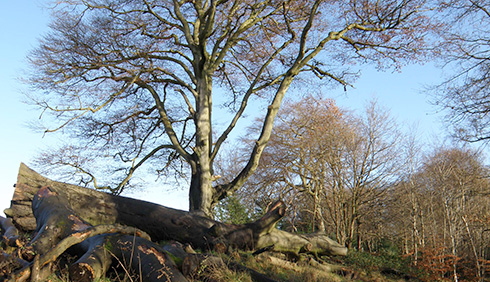
A little further along the path is an oak that must surely be the great-grandparent of many others in the wood, the girth would take four or five tree-huggers to reach around. I love this tree, and often imagine climbing it. Ten years ago, I might have done, twenty, I probably would have done, and thirty, definitely. I can see the way up and the branches where I would sit and look out, waiting quietly for birds to stop fussing at my presence, relaxing into my connection with this wonderful life-form. It’s not that I couldn’t get up it if I really tried, it’s more a blend of self-consciousness ( I realise that it can be disconcerting for other people to find middle aged women alone up trees) and a respect for the tree. It is an elder. It – he, she – has the dignified seniority of a true chieftain among trees, and my presence under those wide, tangled branches is deferential. Looking downwards, I wonder at the roots hidden beneath my feet, an unseen reflection of the branches, anchoring this oak in the earth, drawing up goodness knows how many gallons of water a day, for goodness knows how many centuries, interlacing with the roots of all the surrounding trees, competing, and I think communicating in some mysterious fungi-related way: a living network known to worms and grubs if not to us.
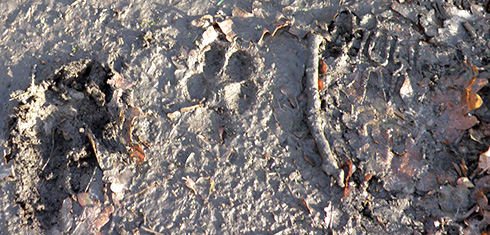
Leaf-litter covers much of the soil. Dog pawprints track through mud which human boots more carefully avoid, and twigs lie in varying stages of decay. Further still into the wood, a walkway protects walkers from the bog – and protects the bog from walkers. Wrens and robins flit about the undergrowth, according to their own territories and daring acts of trespass, and the wildness, the brokenness, the variety, the vivacity, the rich entanglement of living and dying, rotting and regeneration goes on and on. Where an old willow trunk split and fell into the bog, many withies have sprouted from the horizontal branch. Where trees begin to die, moss and fungi take hold. Amongst leaf-mould, tiny holly seedlings poke through. A rotten stump, half buried in leaf mould, is now adorned with a peach-succulent flourish of fungi.
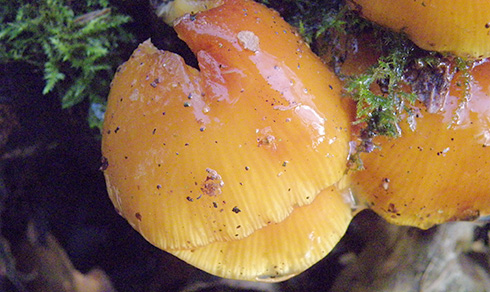
I must have found ten or twelve varieties of fungi just on this walk, and I cannot name most of them. Often I come home and trawl through identification guides, but find myself at a loss, there are so many. I have been able to identify most trees and many wild flowers and birds since my early days, but fungi remain mysterious. These days, I am more willing to accept that I don’t have to know the name of everything to be able to appreciate it. Simply to see the way this particular cluster of golden domes has claimed this stump as home and source of food, is enough. I feel awe at the power of life – and death.
For soil to be so nutrient rich, it has to have embraced the dying and allowed it the time and space to decay. Decay itself is awesome, the process of breakdown and reorganisation of atoms and molecules into something else, the way living things give up their bodies for the sake of new life ... I think of St Francis who, just a short while before his own death, wrote the beautiful hymn to brother sun and sister moon, in which he praised God too for ‘sister death’. Francis, with incredible humility, saw the natural world as beautiful and good and full of God’s wisdom – even the death and decay that was creeping over his own diseased body. We develop our intuitions and theories about dying and ‘what next’, allowing our chosen faith path to inspire us; but the earth too invites us to let her wisdom inform our hopes and fears. Jesus himself, according to the gospels, reflected on the earth a good deal to talk about death and ‘what next’ – including his own death:
Very truly, I tell you, unless a grain of wheat falls into the earth and dies, it remains just a single grain; but if it dies, it bears much fruit.
John 12:24
So, wonderfully, through the winter, the soil holds its secrets safe; seeds, bulbs, corms, lie waiting. Trees, their roots sunk deep and wide, wait too, their inner life regenerating, closed to the outer world. We see death, fear finality, ‘the end’, but all the while, there is change, flow. Nothing – no ‘thing’ just disappears, it changes. And so do we. (For a New Testament reflection on this change, drawing heavily on natural imagery to explore the idea of resurrection, read 1 Corinthians 15).
I go on, because there is an especially powerful place in these woods. About 5000 years ago, people were here, and we know it not because of skeletal remains or arrow heads or pots and beads, but because of stones. ‘Burnt mounds’ reveal the remains of what seems to be ancient sweat-lodges. Rounded pebbles and cobbles lie about, some in the stream, with the tell-tale blackened, bronzed sheen that shows they were once placed in a fire pit, used to heat water and produce steam, then put on one side.
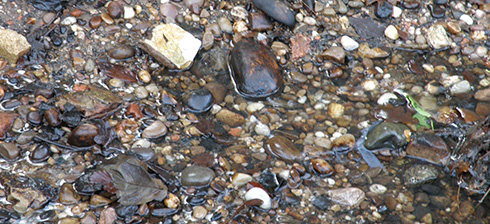
This place, to me, is a peace-place, a cleansing place, where people shared the dark intensity of a sauna made of poles and skins and emerged naked and blinking into daylight. It’s an ancestral place where I find hope that humanity has always been able to gather and work cooperatively, sharing moments of depth, entering into vulnerability together in trust. It’s the history we don’t usually see. With so much violence in the world and in our hearts, I need signs of hope like this place, that allow me to believe in our intrinsic capacity for gentleness.
Squatting with my back against a birch tree, the brokenness and vibrancy of the woodland all around, it’s as though those sweat-lodge people are just the other side of a bramble thicket, the children I can hear playing further down in the stream, their children, the bark of a dog, one of their hounds. 5000 years in human terms is so difficult to reach back to – about 250 generations – yet there are trees on earth which are just about that old. The old yew nearby, may only be two or three yew tree generations away from those sweat lodges, and if the oak I passed at the beginning of the walk were 500 years old and still bearing fruit, it’s only 10 more similarly venerable oaks back in time. The people may have moved on, we may have forgotten these ancient ways, but these trees are the children of the ones present at the time of sweat lodge ceremonies. To me, there’s something remarkable about that, and the way a charred stone can lie on the earth since the days of Stonehenge, smaller, humbler, but equally evocative of human interconnection with the environment.
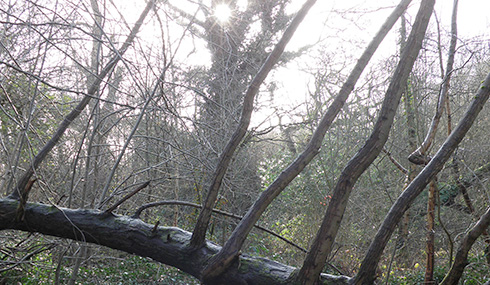
Suggested Response
- Wherever you live, find places where you can make contact with the earth rather than tarmac. If walking is not an option, scoop soil into a bowl to touch, or pot some bulbs in compost. Perhaps you have a compost bin to maintain, or can start one up.
- Experiment with prayer walking and see how you feel about it – or just practise walking or moving with greater awareness of your body and environment in the present moment.
- Go back to the biblical references in my article and spend time reflecting them, or with other passages of scripture which draw on the earth for wisdom – of which there are many.
- Take time to notice different trees and to imagine the roots beneath the ground – the wholeness of the tree rather than just the part you can see.
Please bookmark this post at Facebook or Twitter:


Your comments:
Hi Barbara,thanks for your feedback, it makes a real difference to me. Hopefully there will be another of my posts in the spring, meanwhile, enjoy your prayer walking! Annie
#2. By Annie Heppenstall on January 16, 2014
Annie, I found that a very moving piece of writing and was absorbed by your connections with your own local place. I live in the beautiful County of Norfolk and we are going to try offering Forest Church to people here. One of my favourite sayings of St. Francis as he gazed at the stars was, ‘If these are the creatures, how beautiful must the Creator be’. Philip Young
#3. By Philip Young on February 26, 2014
Hi Philip, thanks for your feedback, I’m glad you enjoyed my article. you might also enjoy my blog, which has similar kinds of articles http://annieheppenstall.blogspot.co.uk/
I hope your forest church venture blossoms ![]()
Annie
#4. By Annie Heppenstall on February 26, 2014

Pleasley Forest Church
Encountering the Eternal One within the ancient boundaries of Sherwood Forest More ...

Essex Forest Church
We seek to find the presence of God in the open air and in nature, and to connect with the Divine Being who is present in creation. We seek to foster a love of creation, a love which will lead us to care for it. We look for reconciliation between nature and human beings, and within human relationships. More ...
oxforddiocese:
Great to see how @RiponCuddesdon are engaging with @ARochaUK Eco Church scheme - love the Forest Church area made b… twitter.com/i/web/status/1…
18 Aug 22
YBS_Church:
Our Forest Church takes place on Sunday, 28th August, at 4.30pm in the Gifford Community Woodland (Fawn Wood), for… twitter.com/i/web/status/1…
19 Aug 22
rebeccaBug:
Tremeirchion have their first Forest Church service tomorrow so the boys thought they had better check out that the… twitter.com/i/web/status/1…
20 Aug 22

Thank you for your lovely article. It very much fits with my own practice, but has encouraged me to go and do more ‘prayer walking’. I eave a health condition which can make rough walking challenging, so I appreciated your awareness that not everyone who feels a close connection with nature can shin up trees at any opportunity(although I used to love it!) I also really appreciated your awareness of the history and human presence in the area you describe. Many thanks- do post some more!
#1. By Barbara on January 15, 2014